A few weeks ago, John mentioned to me that one of the audio mixers in the art and technology / Internet radio station lab had stopped powering on. I said I’d have a look at the power supply and see if I could fix it, and he sent it with me. Turns out we both got a little more than we bargained for — I in terms of effort required and he in terms of time without the mixer.
I didn’t know whether it’d be a linear or switching power supply, and it turned out to be switching. I figured it’d just have some baked electrolytic capacitors I could replace, and it turned out that was just the beginning.
I’ve got it mostly fixed now, and it’s been a long and interesting road.
Getting In
First off, you can’t get into the mixer from the back, so I had to take every knob, screw, and nut off the front panel. I’ve had this assortment on my workbench for several weeks, in the way and patiently waiting for reassembly.
Here’s the main board. It’s so hard to see the active components, it looks almost like it’s just a control board, but that’s the whole deal — all the op-amps are tiny little SMT jobbers hiding between the jacks and faders.
Then I had to dig the power supply out of a gully in the back of the case — yet more screws to keep track of.
Capacitors
See that scorched area in the upper middle of the board? I was suspicious of the two electrolytics right next to it.
I pulled out Ye Olde Capacitor Wizard, and sure enough, C1 and C8 (47uF 63V 85°C) both tested way bad. I replaced them with 47uF 100V 105°C capacitors, raising to get them a little further away from the resistors that I assumed were the source of the heat. This is probably not kosher, but then neither is failing to take thermal considerations into account and baking the capacitors.
And voom! The power supply … er, still didn’t work. Durn.
Sam’s Switching Power Supply Repair FAQ
Since I knew nothing about switching power supplies other than vague theory — and at the time still had every desire to keep it that way — I Googled for “troubleshooting switching power supplies” and went off to read Sam Goldwasser’s excellent troubleshooting guide. It even has a section on the UC3842 control chip used in this supply.
Alas, none of the problems that “probably account for 95% or more of the common SMPS ailments” seemed to pertain. (I find that they don’t 95% of the time.) Under “Supply dead, fuse not blown,” it suggests a bad startup resistor, bad fusable resistors, and bad controller components.
Startup resistor — okay, now I was having to learn a little more about how off-line switching power supplies work.
In an off-line power supply, ac line voltage is rectified and filtered without using a line frequency isolation transformer. Great; not only is there 110-120VAC in there, and 155-170VDC, but the entire primary side is powered by directly rectified AC and is “live” with respect to earth.
I’ll say it now and I’ll say it again later — don’t poke around in a powered-up off-line power supply unless you have it plugged into an isolation transformer. You don’t want to chance touching a connection that’s hot to earth and having it short through you. You also don’t want to connect the power supply’s floating ground — which is still hot with respect to earth — to your scope’s ground; it’ll send a whole lot of electricity through things before it melts one, the other, or both. For safety’s sake, you’re best off using a battery-powered meter, which doesn’t provide any return path to earth.
Right, back to that startup resistor. In this type of supply, the primary side of the circuit is running off rectified line voltage — in this case, about 170VDC. A high-valued startup or bootstrap resistor is used to provide VCC to the control IC — in this case, as I learned shortly, by charging C1.
The UC3842 control IC is designed so that it turns on when VCC climbs to 16V, increases its current consumption so it’s now draining C1, starts driving the FET to power the transformer primary and hopefully get the supply bootstrapped, and turn off if VCC falls to 10V by depleting C1 before the main supply manages to bootstrap. This is why failed switching power supplies sometimes chirp, chirp, chirp or flash their power LED — which I found out later this one had been doing before it went completely dead.
Once the system is bootstrapped, it draws from a transformer secondary to power the control IC on the primary side.
Startup resistor — right. A bad startup resistor could make the supply never bootstrap. In retrospect, it makes sense that it’s the large resistor in the circuit, because it’ll have about 170V dropped across it, but I wasn’t thinking of that at the time. Which leads me to …
Building a Schematic
Didn’t have one. Needed one. Made one.
I looked at all the components on the board, placed them in EAGLE in corresponding positions, and then joined connections to follow the traces on the board. Then I rearranged the schematic by logical sections, and that’s what you see here (since annotated with voltages you should see at different points in the circuit, for the sake of the next person to repair one of these).
The whole thing makes a lot more sense now. In the upper left, the incoming AC has RF filter capacitors across it, a fuse, RF filter inductors (it physically looks like a transformer and maybe technically is but the coils are side-by-side instead of concentric and it has an air core), a thermal fuse, a surprisingly small bridge rectifier (high voltage but low current), and a big 100uF 400V capacitor.
The primary side of the circuit charges C1 through R13 to bootstrap VCC up to the 16V turn-on voltage. The UC3842 drives the FET that switches the transformer primary. A primary-side secondary is half-wave rectified to provide ongoing VCC to the IC, and the rest of the primary side is kitted out with all the various feedback the UC3842 needs to operate.
The secondary side has half-wave rectifiers with pi filters (capacitor to ground, inline inductor, capacitor to ground) to provide balanced ± power to the op-amps in the mixer. The oddball dangly thing regulates the 48V phantom microphone power.
I’ll note that brown bands on brown resistors look grey to me, leading to some intial confusion as to resistor values.
Testing Begins in Earnest: Bootstrap Resistor
With the schematic in hand, I could now make a logical progression through the circuit, testing components in turn, to locate the remaining problem(s). My plan was to test the power to the IC, the FET drive signal, then the transformer primary power, to isolate the problem to the appropriate section of the circuit, and narrow down from there.
First I tested the bootstrap resistor, R13. Looked good — and I desoldered and lifted one lead to be sure I wasn’t being misled by some parallel part of the circuit. Seemed okay.
I wanted to check the actual bootstrap VCC voltage, because I was suspicous that it might be too low to turn on the chip. To do this, I needed to power up the circuit, so I did two things: I plugged the power supply into my isolation transformer so if I accidentally touched part of the circuit I didn’t intend to, I’d just be hurt instead of (potentially) dead; and I plugged the mixer’s main board into the power supply on my bench, to provide a load.
Switching power supplies that have feedback from the secondary voltage to the control IC are particular about having a load. Although this supply does all of its regulation within the primary side, changing the load will change the current draw of the transformer secondary which changes the current draw of the primary which changes how the circuit behaves. It might be okay to run this supply without a load; but frankly I just don’t know enough and didn’t want to chance it.
Powered from the isolation transformer, with the main board plugged in for load, and using my battery-powered meter (not essential since the supply was on isolation, but the handheld meter was the first piece of equipment I wanted to use anyway), I measured a fluctuating 12-14VDC on the VCC line.
This told me that the system wasn’t bootstrapping, as it should have a steady supply voltage once running — but of course I already knew that. What it didn’t tell me was whether I had a bootstrap voltage problem. I was using my digital meter, which doesn’t have a fast enough response to be sure about the exact extremes of a fluctuating DC signal.
I figured I was going to be spending a fair bit of time testing things on the supply, so I soldered a wire to the primary side’s big capacitor’s negative terminal to use as a ground point to clip my scope’s ground lead to — I didn’t want to try to clip it to a short component lead and have it pop off and touch something else while I was testing.
Scope said 16V falling to 10V on each cycle. Aight, not a bootstrap resistor problem.
Testing the FET
Next I put the scope on the FET’s gate — lack of drive signal there would indicate that the control IC was hosed. I did have drive there:
It shouldn’t be ramping down like that, but that’s just a consequence of the bootstrap VCC draining away C1 as the supply fails to boot.
The next logical point to check was the junction between the FET drain (top) and the transformer primary, but I was still being chicken about hitting that 170V with the scope. Instead, I looked at the cathode of D2, the half-wave rectifier for the primary-side’s transformer secondary that’s the first step in providing ongoing VCC for the control IC.
It’s being filtered by C8, hence the smooth curve — but look at the amplitude. The transformer is providing only ~3VDC to the circuit; that can’t be right.
Now, I didn’t think the transformer was bad, but shorted coils in the primary side’s secondary would result in a lower voltage there and could have this effect. So I measured the ultimate DC output of the secondary side of the circuit — the voltage that was supposed to be going to power the op-amps — and saw it fluctuating from about .5 – .9V. It seems beyond comprehension that all of the transformer’s secondary taps should have shorted coils all at the same time, so I ruled out a transformer problem.
It’s worth noting that I didn’t need to consider a problem on the transformer primary — at least, not any sort of problem I’m familiar with. The two transformer failure modes I’m aware of are an open circuit and shorted coils. An open circuit in the primary side just makes it not conduct and nothing happens at all. Shorted coils decrease the primary inductance and increase the ratio of primary:secondary turns, increasing the secondary voltage (often catastrophically).
Since I had a decreased secondary voltage all around, I assumed there was nothing wrong with the transformer, but rather that there was something wrong with the power going into it.
Back to the FET, then. I still wasn’t ready to poke at the 170V, so I scoped the signal on the FET’s source (bottom), at the junction between it and the current-sense resistors.
Looked basically fine. That is, it was varying between 0V when the FET was not conducting and a higher value when it was conducting. If the FET were broken in a simple way, it would be never conducting (or always shorted), and I wouldn’t see the set of pulses as it pulled up the voltage on the sense resistors.
Fine, fine, FINE. I’ll check the dang high-voltage side.
I did switch the scope probe and the scope to 10x first.
The FET drain looked fine too — 170V most of the time, dropping to about 0V when the FET was conducting.
And I wasn’t dead. Or even injured.
Wait — What Next???
Not a bad bootstrap. Not obviously a bad control IC. Not obviously a bad FET. Not apparently a bad transformer. What the heck???
I spent more time pulling components out of circuit and testing them. C2, the small capacitor that parallels C1 on VCC to catch spikes — tested fine out of circuit. R6, R7, and R9, the current-sense resistors — really 1Ω. D2, the half-wave rectifier for the primary-side low-voltage supply — tested fine out of circuit. R5, part of the voltage divider for the voltage regulation feedback — good. What, what, what.
Bad Zener
Everything on the control side appeared to be operating properly, but the transformer’s secondary voltages were far too low. It really seemed it had to be a problem with the transformer drive circuit, and I wondered whether the FET was weak in a way I was having trouble seeing on the scope — not conducting the full current through, or something.
I found in my parts bin a similar FET also made for ultra-fast switching in power supply applications, albeit at a slightly lower current rating, and swapped it into the circuit. No discernable change. Swapped it back out.
Then I looked up to the network above the FET on the transformer primary — the catch circuit for the inductive kickback. In simple terms, when you’ve been running current through an inductor and you switch off the current source, the inductor wants to keep the current flowing and causes a voltage spike in the opposite direction of your power supply. Placing a reverse-biased diode across the inductor will have no effect during normal operation, but allows the “wrong-way” voltage to be dissipated during the spike, saving wear on the other components.
D5 is that reverse-biased diode, and I hadn’t been able to read a part number on D6 while it was in-circuit (the number was facing down) but knew it must be a Zener — a diode used in reverse, which only conducts (in reverse) when the voltage across it exceeds a certain amount, called the Zener voltage. In simple terms, it clips the (reversed) voltage across it to its rated Zener voltage; or put another way, it doesn’t conduct (in reverse) unless the (reverse) voltage across it is more than the Zener voltage.
So this is a Zener diode, which is used in reverse, applied in the inductive kickback circuit, where diodes are used “backwards,” with the two reverses making it look like it’s used forward — which is why I assumed it must be a Zener. Its purpose must be to shunt the inductive kickback only when it exceeds a certain threshold above the supply voltage, instead of all the time.
I appear to have misinterpreted the function of C20 in this next section. See the comment from MikeS.
C20 is not something I usually see in kickback circuits — the only thing a capacitor can be doing there is catching some of the kickback and adding it to the next forward-going pulse. Oh, very clever! Instead of wasting the kickback by dissipating it all into the power supply, C20 recycles it, increasing efficiency.
And D6 sets the maximum voltage that C20 can catch, discarding the rest. With a traditional reverse-biased diode there, all the kickback would just dissipate through the diode and C20 wouldn’t get to keep any.
I was now wondering whether something was wrong with this catch circuit. It seemed much more likely that one of the diodes would have failed than the capacitor or resistor, so I started with the diodes.
When I measured D6 in circuit, it looked like it was conducting both directions. Oh, I thought, that’s because of other components in the circuit, so I pulled it out and measured it again. Still conducting both directions, a lot. Eureka! There’s the problem — it was dissipating all the kickback through D5, with D6 acting like a dead short, and C20 wasn’t getting to keep any, and C20 was critical to powering the transformer!
Now out of circuit and completely legible, I could see that D6 was a 1N5378B 100V Zener. I couldn’t find anything in my parts bin close to an acceptable substitute, and I didn’t want to place a parts order until I was sure that was the last thing wrong with the supply and I didn’t need to buy anything else, so I really wanted to find a substitute and check. And I had a feeling there was something else I could use, but I couldn’t think of what it was.
Faux 100V Zener
The next day I talked to Tom McGuire and John, asking if they had any 100V Zeners at work and whether they could think of anything else I could use.
They didn’t have any Zeners big enough. Tom seconded my suspicion that I could probably run it without the Zener long enough to test, letting all of the kickback go into C20 instead of shunting some; but I didn’t want to take a chance of breaking something else in the circuit at this point, so I was leery of trying that.
And then Tom reminded me of what I couldn’t think of — a neon bulb.
A small neon lamp will start conducting when its voltage exceeds about 100V (perfect!) and keep conducting until the voltage drops below maybe 60-70V (unimportant for this application). They have a long history of being used as voltage regulators in addition to indicators.
With the shorted Zener out of the circuit and the neon bulb in, the power supply worked and the mixer powered up! I couldn’t ever see the bulb light so it’s possible the kickback was never exceeding 100V, or never for long enough to light up the bulb, but I felt better having it there.
I poked around the rest of the circuit and everything else looked okay. I placed my Digi-Key order for some other stuff that had been accumulating on my shopping list, got the order yesterday, replaced the Zener, and now the mixer is tip-top!
Well, actually no.
10MHz Ringing
I was going through taking measurements of correct, baseline voltages and frequencies to add to the schematic for posterity, and I noticed that the VCC line looked awfully noisy. I zoomed in on it and found massive ringing, with the leading spikes happening at a period that appeared to correspond with the FET switching frequency and the individual oscillations in each ring at about 10MHz. I rechecked all the capacitors, replaced some anyway, supplemented some, and absolutely couldn’t get the ringing to go away.
Now, 10MHz is way above audible frequency (except perhaps for golden-eared audiophiles ![]() ), so I wasn’t worried about hearing it. Plus it was only on the primary side of the circuit, so I was pretty sure it couldn’t couple through the transformer to the secondary. But I didn’t figure it was great for the control IC to have that on its supply, and I was worried about it shortening the life of other components. So I really wanted to get it figured out before closing up and returning the mixer.
), so I wasn’t worried about hearing it. Plus it was only on the primary side of the circuit, so I was pretty sure it couldn’t couple through the transformer to the secondary. But I didn’t figure it was great for the control IC to have that on its supply, and I was worried about it shortening the life of other components. So I really wanted to get it figured out before closing up and returning the mixer.
I traced the ring to lots of different points in the circuit — back up toward the transformer, all over the place. Finally out of exasperation I put the scope probe on the same ground point I was clamped to, more as a joke on myself than anything — and saw the ringing there too, clear as day.
Trace 2 is the FET gate drive; trace 1 is noise on the ground plane. There’s almost a volt of spike on the ground plane every time the FET switches on and off. I hadn’t been seeing noise everywhere else throughout the circuit; I’d been seeing noise as measured between each point and noisy ground.
(Okay, how can a scope register a signal between its probe and its ground when they’re connected to the same point? I assume its ground connection is capacitor-filtered and its probe obviously is not. That could mean that I wasn’t just seeing dirty ground everywhere and there really is noise throughout the circuit — but I know there shouldn’t be that kind of noise on the ground plane, and I want to eliminate that before worrying too hard about the rest.)
Here’s the same thing zoomed in,
and a closeup of just the first ringing.
To add insult to injury, the only connection between the primary and secondary sides of the circuit besides the transformer is C24, which capacitively couples the two ground planes. (I don’t fully understand why.) And C24 couples the noise into the secondary side’s ground slick as can be, where it appears on the power going to the mixer. Crap.
My immediate intuition was that the big 100uF 400V capacitor across the power supply was aging and no longer able to respond to transients as fast as 10MHz. When the FET switches on, the circuit makes almost a dead short between +170V and ground through the transformer; it seems natural that ringing during the transistions should appear on both the power and ground lines, and C18 is the only thing that would really be in a position to catch it.
It also occurred to me that maybe this ringing has been there from day one, and either the engineers didn’t notice or didn’t care. But that’s not a happy thought; and as I don’t have access to an identical mixer to see how it operates, I’ll just push that back to the dark, cynical recesses of my mind.
C18 has a lot of capacitance; but it’s so big, it might not be able to respond quickly enough to very fast spikes. This, I assume, is why C2 is paralled with C1 — so perhaps a smaller-valued capacitor in parallel with C18 would help kill the 10MHz ringing. (Perhaps a brand new replacement for C18 would do the job also — but if that fixed it, then in a few years the new capacitor would have aged enough to regain the same problem. Better to fix by design than by manufacturing.)
I found a 330nF capacitor that looked like I could trust it with 170V plus spikes and soldered it on in parallel with C18, and it doesn’t appear to have made any difference. Also tried 4.7nF, 150pF, and 47pF (shown here), all with no apparent change to the ringing.
I don’t have many ideas left, and I’m really not happy leaving the power supply the way it is. Maybe someone out there with more design or repair experience has a suggestion? Maybe the scope is playing tricks on me and someone can explain how?
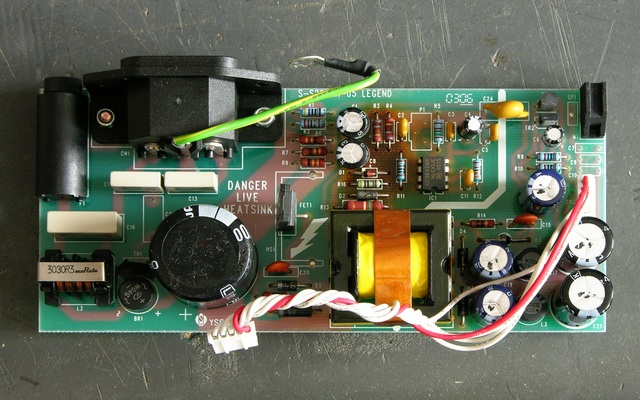
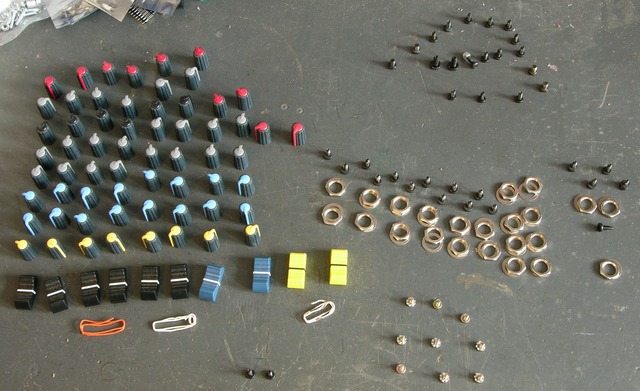
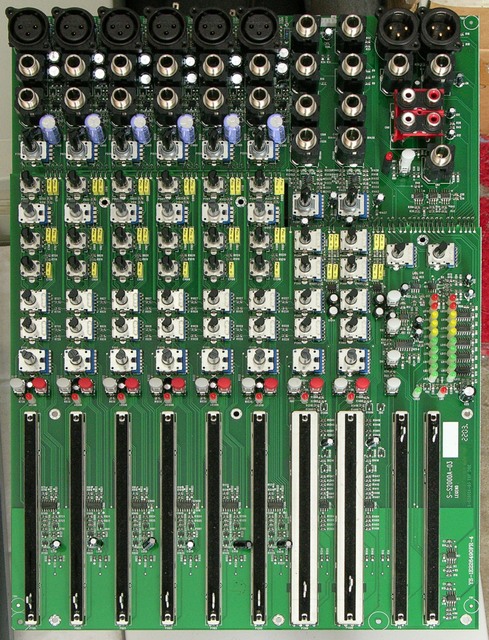
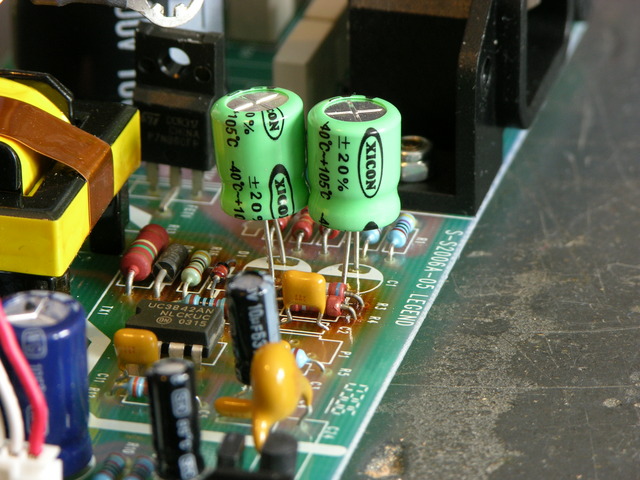
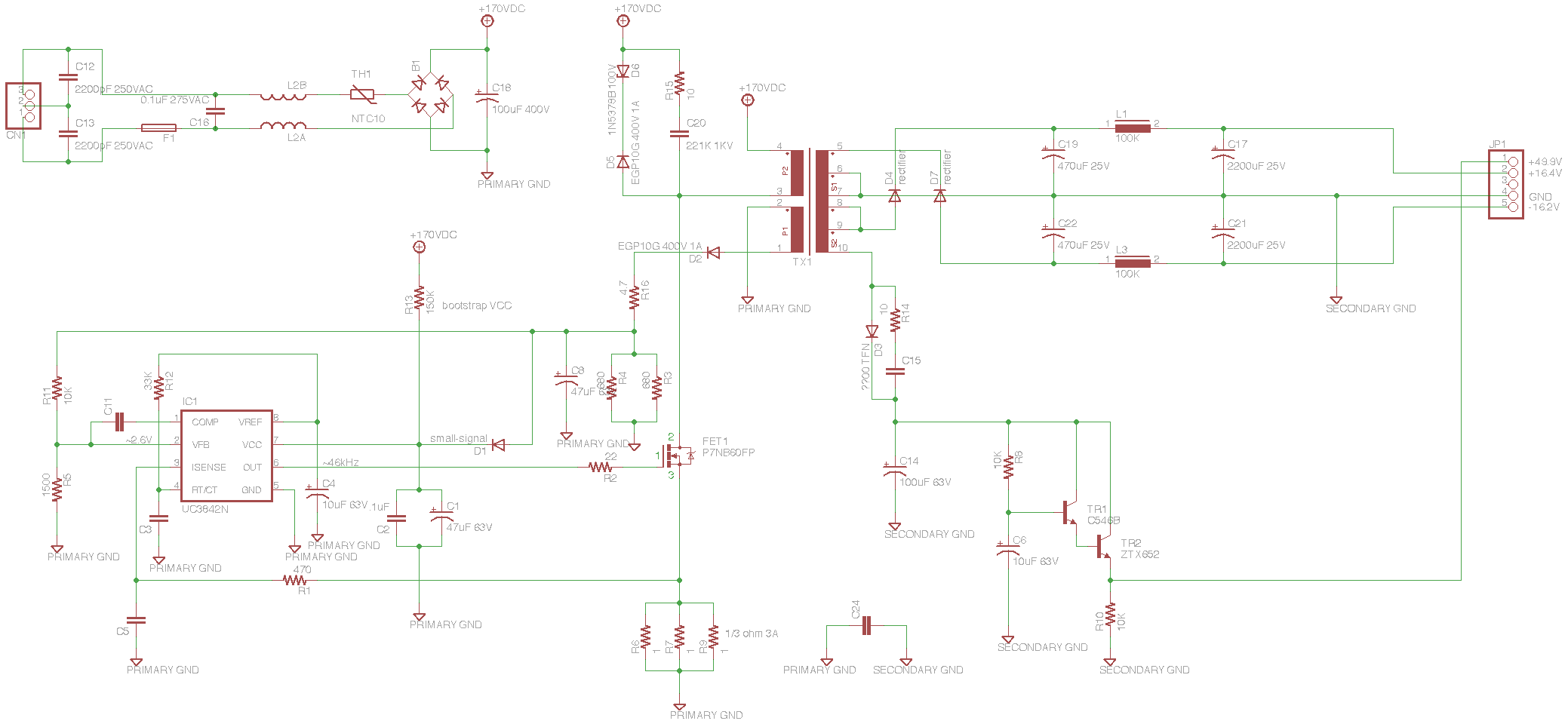
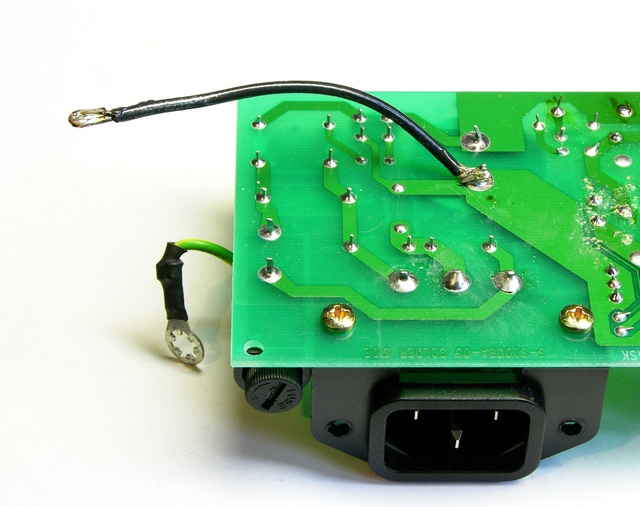
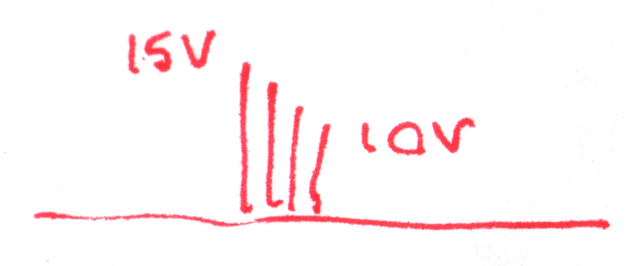
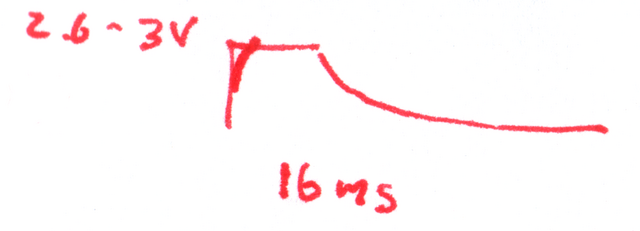
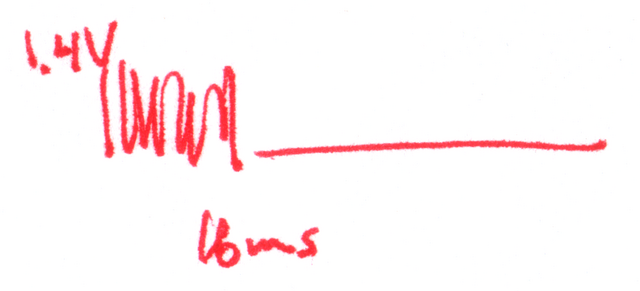


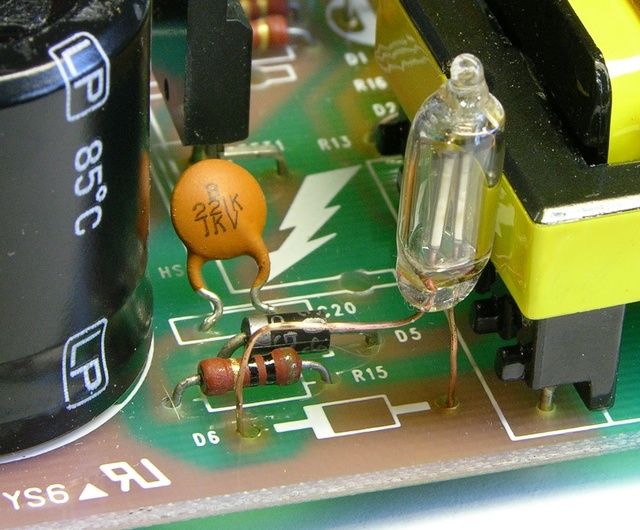
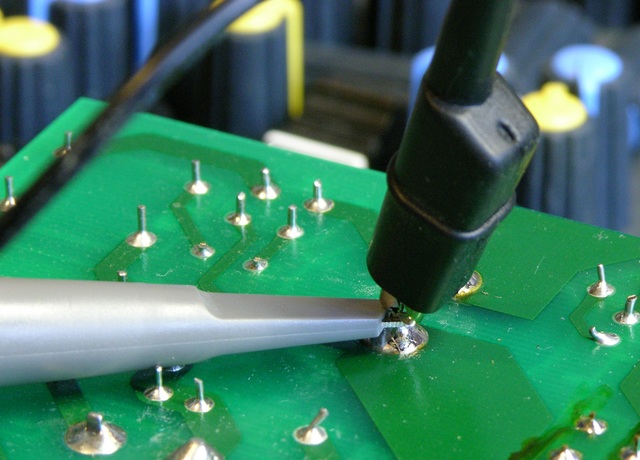
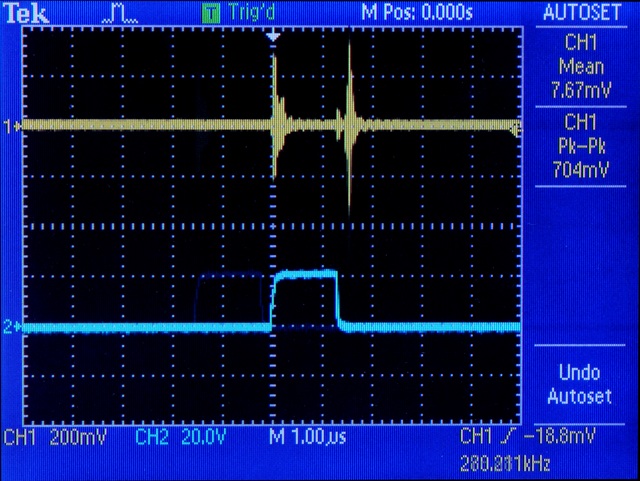
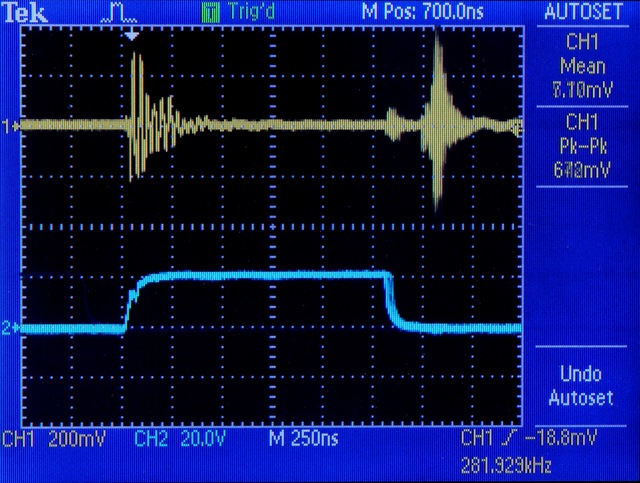
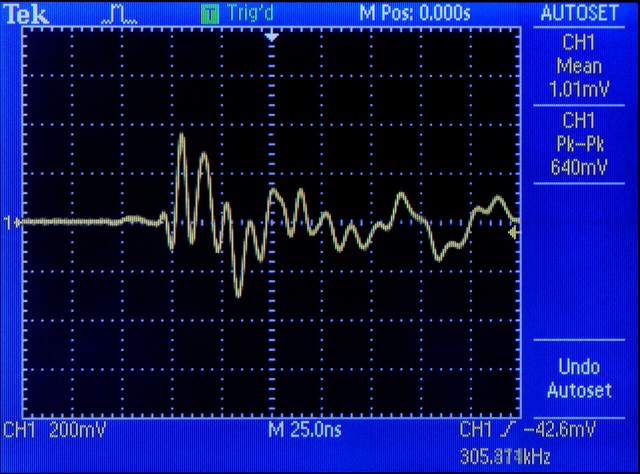
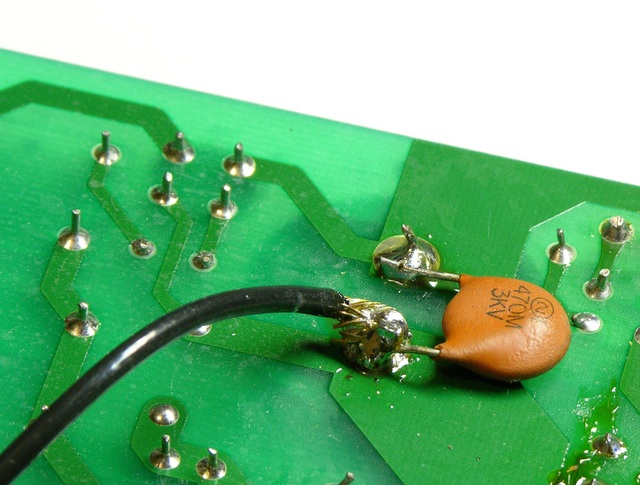
Wow, how long does it take you to document all this stuff?
I enjoy reading the investigation, reminds me of a repair column I used to read in Electronics Australia magazine when I was a teenager.
–Phil.
I’ve worked on switching regulators and the 10MHz you are seeing is not unusual. It may not even be important so I commend your dedication to quality.
C20 and R15 actually act as a snubber and deliberately waste a little bit of power. They are reducing the 10MHz oscillation. Take them out and you wll see the oscillation get worse. You may need to adjust them as you have changed other components.
There is another fixl fix. Increase the value of the resistor driving the FET. This way the FET turns on and off more slowly. This will not eliminate the ringing only reduce it. There is an accidental resonant circuit and the harder you hit it, the louder it rings just like a gong. The down side is the reduction in efficiency as the FET will spend more time in a region somewhere between completely on and off so will dissipate more power.
MikeS, thanks a ton for the insight!
It’s nice (although a bit disappointing) to know the ringing is common. That does mean I could just stop here.
Do you know offhand which way I should adjust C20 – R15? Since I have resistors in (at least) E24 values and capacitors in (at best) E6 values, it’d be easier for me to play with different resistor values.
To adjust the snubber you decrease the value of the resistor and/or increase the value of the capacitor. This causes it to suck up more energy which will damp the amplitude. It will probably change the frequency of the oscillation too. Again, this will reduce the power supply efficiency.
If you get carried away you may have power dissipation problems in the snubber. Of course, if you get super carried away the whole thing will stop working.
MikeS, thanks again! I’ll give that a shot tonight.
The PCB seems to be well made and I’ve desoldered and swapped some parts four to five times already, so I’m comfortable going a small step at a time with the resistor and checking results along the way.
So … any other mistakes or oversights in my troubleshooting and description? I’m obviously no authority on switching power supplies, just an interested student.
Great post. Please update if you find the solution.
Love these posts. The bit where you go “And voom! The power supply … er, still didn’t work.”, that’s my experience level right there!
Fatlimey, there was also a hint at that point of, “This mixer wouldn’t voom if you put ten thousand volts through it!”
follower, I take photos and notes as I go and tend to paste them into the (unpublished) blog post every night when I wrap up for the evening, so most of the information gathering happens along the way.
But yes, it does take me a while to go back and write the narrative.
Still, I feel it’s my small contribution to society. If there’s one person out there who’s able to fix a broken mixer because of my notes on how I went about it, or one person who gains the confidence to tackle a broken switching power supply, it was all worth it.
Growing up and in the early years of my career, some of my heroes were (and still are) Forrest Mims III, Cricket Liu, and Larry Wall. Each excelled in a technical field, and each brought a gentle humanity as they made their expertise available and intelligible to everyone.
They set good examples to emulate.
Forrest Mims III is quite active as the editor of The Citizen Scientist, the publication of the Society of Amateur Scientists:
http://www.sas.org/
(And, yeah, I owe him an article or two…).
Another great is Dennis Ritchie. I’ve corresponded with him in the distant past, but haven’t been in contact with him for a while:
http://en.wikipedia.org/wiki/Dennis_Ritchie
Another great is Mike Cowlishaw:
http://en.wikipedia.org/wiki/Mike_Cowlishaw
I’ve had the pleasure of meeting him, long long ago.
As for switching power supplies, don’t forget that CFL light bulbs basically have a switching type supply in them.
http://www.pavouk.org/hw/lamp/en_index.html#electronics_repair
Dave
MikeS, no luck yet on changing the snubber values. I increased C20 up to 500+pF using parallel (high-voltage) capacitors, and reduced R15 down to 8-9Ω using parallel resistors and couldn’t measure a change in the amplitude of the ring.
Should I be having to change values by a decade or more in order to even see a difference?
Good work on reverse engineering the schematic, that looked like a pain. Don’t you wish they’d give you the schematic?
R15 looks like it’s 10 ohms so changing it to 9 ohms wouldn’t have much affect. C20 is labeled 221K which might mean 22pF. Changing it to 500pF should definitely have an affect. I think you’re done with that experiment since that made no change.
Also, re-reading the article you should be aware of something called a capacitor’s ESR (equivalent series resistance). Components are not perfect and one of capacitor’s typical faults is their internal resistance. The caps you changed out might have cooked themselves without any help from the resistors as current flows in and out every cycle.
I love the troubleshooting story but have little worthwhile to contribute.. Just out of curiosity, what scope are you using?
Kai, the scope is a Tek TDS2002 borrowed from school. I don’t trust my analog scope’s calibration well enough to use it for measuring voltages, and it certainly doesn’t have enough bandwidth to capture 10MHz.
MikeS, I didn’t waste much time searching for a schematic. I might have been able to negotiate one out of SoundCraft, but I bet it would have cost me more than the time it took to make this one.
I’m familiar with capacitor ESR (the Capacitor Wizard is an in-circuit ESR tester), but I hadn’t thought of it in the context of converting electrical power to heat. That’s an interesting point! Do you suppose the capacitors are what scorched the board?
On a second look I realized your pictures are clickable and they are nice high resolution in focus pictures. Since the scorch is not under the caps, it sounds really unlikely the caps caused the scorch. Unless the old caps leaked their innards?
Depending on what kind of caps the old ones were, they may have started out as low enough ESR and dried out as time goes by increasing their ESR. Then they self heat and dry themselves out even more in a bad cycle.
Hi Keith. I just looked at the scope patterns and realized the magnitude of this ringing problem. I was thinking we were talking about a constant wave oscilation or something. Considering the amplitude of the voltage and the amount of energy this represents I would say, Put the lid on, It’s good. 50% of it at least is the scope playing tricks on you.
Nice work. Love your blog.
Tom
One thing that’s been worrying me is why the circuit board is scorched. That would seem to indicate that something was getting hotter than it should have. However, with the 150K value for the bootstrap resistor, there’s no way that it should have been getting that hot with only 154 Volts (170-16) across it. Even if you did a worst case analysis, and considered the entire DC voltage across it, and consider that a high line voltage condition may have pushed the DC voltage up to 180 Volts DC, that resistor should still only be dropping about .21 Watts. It’s hard to tell from the picture, but it looks to be a half-Watt sized resistor, I think.
However, doing an analysis on R3 and R4, which should have 16 Volts DC across them, and with their value at 680 Ohms, these will be dissipating .38 Watts each. Again, it’s hard to tell from the photo, but are these half-Watt resistors? Still, that’s a bit close to the maximum rating for something that is enclosed in a case,
and with the resistors right up against the circuit board where the circulation of air is limited. Would it be worth increasing these to 1 Watt resistors?
Dave
Keith, I really enjoy your site and your attention to detail. Regarding your noise issue: The ground bounce you are seeing and the test you performed are something I run into all the time. It means that your circuit is being pulled away from ground and causing currents in the scopes ground. Try removing the tip and ground lead and shorting the tip and ground with a bus wire and repeat the test. It should reduce the noise. To get rid of it I would concentrate on the input filter and C24. Take a look at this paper – it helped me understand whats going on:
http://ecee.colorado.edu/~ecen5797/course_material/layout.pdf
Hope this helps, Bill
If you are still working on the power supply you can try clipping the probe earth lead to the tip and placing it close to the PCB. You will probably get the same spikes as the PCB is radiating a bit. The long probe earth lead acts an an aerial. A better way to look at the cap voltage is by using the probes earth spring if it has one see
http://www.cliftonlaboratories.com/july_2007.htm
about half way down for an example and an explanation.
Expect it is now working as intended.
A ceramic cap across an electrolytic helps as the ceramic has very low ESR and inductance and removes the high frequency noise when the electrolytic is giving up.
Regards
Mark
Another very enjoyable troubleshooting article. Thank you for sharing!
Keith, Exellent work! I can’t tell you how much I’ve learned from this. I work on circuits that use these little smps all the time. This is been an absolute learning experience for me. Thank You.
Interesting, a week ago my soundcraft spirit ES mixer made a pop noise and stopped working. Found this site through google while looking for clues…
I started pulling the mixer apart last night, my psu board appears identical to yours, and has the same browning/scorch mark in the same place as you have pictured above.
I havent tested any components yet, but spotted one electrolydic cap at the very top of a stereo channel (your stereo channel looks the same) had blown the can clean off. The channel clip LED lit up and the mixer had no audio output. So there appears to be some power at least.
Let me know if you want me to check anything against your circuits
Matt, the fact that you have LEDs lighting up suggests to me that your power supply is fine and your problem is confined to the mixer board (the opposite of what I repaired). I wouldn’t worry about the heat marks on the power supply board — that’s just a consequence of their design decisions.
I’m wondering what event cause the electrolytic to blow. Are the other identical electrolytics bulging? If so, you may have had a bad batch and need to replace them all.
Regardless, even though there’s probably collateral damage besides the electrolytic, I’m surprised that the entire mixer now has no audio output. That suggests considerably more damage to me.
If it were my mixer I’d try all the inputs and all the outputs and see if any work; that would give a clue where the problem is. I might then trace the signal path from a channel fader through the op-amp filters to the bus toward the mixer op-amps and see where it stops.
Good luck!
I am having the same problem with a Spirit E12. I also saw the dark spots around D5 and 6. I checked them and they both read under 5 ohms in circuit. I found a technical manual with schematics at
http://www2.produktinfo.conrad.com/datenblaetter/300000-324999/300789-sp-01-en-Soundcraft_Mischpult_E8.pdf
That’s as far as I got. Thanks for the great article.
Lenny, nice find on the service manual! Gosh, the power supply schematic looks familiar. Actually, it really is weird seeing how similarly they laid out their schematic. I think it goes to show that there really are some driving aesthetic forces in the sciences.
Actually, it really is weird seeing how similarly they laid out their schematic. I think it goes to show that there really are some driving aesthetic forces in the sciences.
Anyway, sorry about your mixer. Do you have an isolation transformer, that you can measure the voltage at the bottom of R13 (where it connects to pin 7 of the IC) and see if it’s doing what it’s supposed to?
I have got the same problem, after repairing my power supply with the diode.
No output but a deep noise. Inputs seem to be ok, PFL works.
can anybody give me details of a spiritFO8A MIXER I CANT FIND ANY INFO ON IT IT BLOWS THE MAINS FUSE THE POWER SUPPLY IS A BASIC 2X RECTIFIERS PLUS 2 VOLTAGE REGULATORS A KA7815 AND KA7915 CAN ANYBODY HELP PLEASE
Well done Keith for going more than an extra mile on this repair. I have a Spirit ES which shares the same PSU. To my horror on Sunday morning smoke puffed out from the mic 1 fader. To cut a long storey short, I found that the PSU was kicking out +&- 37v. I didn’t bother checking the +48v rail. There is no sign of component break down so it’s probably shorted turns in the HF transformer.
These switching PSUs are cheap to produce but in the case of this one’s design there is no protection for the load should a fault occur. It can happily provide excessive current too so some of the mixer components went up in smoke.
I am now replacing it with a traditional series regulator PSU with fuses and Zener diodes on it’s output, – home brew of course
Andy, pity you’re not in North America. I’d be really interested in troubleshooting your dead PSU as a purely academic exercise, but overseas shipping is probably prohibitive.
Hi Keith, When I get the replacement working I will ship it to you if you like. On the plus side, the series regulated supply will resolve the 10mhz ringing which was a cause of annoyance to FM reception.
I am currently trying to find a 7905m regulator. I already have a small PSU built with 7912 and 7812 and want to bump up the output with small regulators in the ‘ground’ legs of these regs.
Andy, I haven’t played the kind of tricks adjusting the output of fixed-voltage regulators that you’re describing. Would a 5V Zener do the same thing for you?
Well updating my progress… I found the same diode was blown for me also. I have just replaced it and now find the psu is putting out +/- 37V and 16V for the phantom power. Perhaps the same as Andy above?
Note that this was when the psu board was unpugged from the mixing desk board. Now i’m wondering if this is perhaps the normal output for an unloaded supply, but i dont want to plug it into the mixer and blow everything too…
Ive traced my popped capacitor from the service manual to a cap coupling the output of the gain circuit to ground (see 10V, 100uF cap on page 1.10), perhaps for high signal frequency suppression… It’s beyond me how that could have blown like it did…
Yes Keith, you’re right. It was sometime after I added my last comment that I also thought’ what about using Zeners to elevate the ground reference. This I shall do forthwith.
Matt, I’d be very surprised to hear of shorted turns in the transformer primary. Additionally if that were the (only) problem, your phantom power output should have scaled up by the same ratio (2x?) as did the main power.
You raise an interesting question about the unloaded secondary, as it definitely does not have feedback to the control circuit on the primary. As a test, you could try putting a 1W resistor in the (very broadly) 3.7KΩ range across one of the secondary outputs. If I’m doing the math correctly, that should cause a 10mA (370mW) load, which should be enough to pull down the unloaded voltage if that’s all that’s going on right now.
Seems like it could be an informative test.
Because the power supply I repaired showed no signs of damaging the mixer, but merely didn’t power up in a very traditional switching-power-supply-not-powering-up sort of way, I never ran it without the board plugged in. But I understand your caution under your differing circumstances.
Hi again Keith
Well I loaded up the power supply (after replacing D6) and the voltage dropped back down to roughly fluctuating +/-0.5V … I checked D6 and it had blown again. I replaced and did much the same thing and blew D6 a third time
Did you have any insight into the cause of D6 blowing? I’m going to start replacing all the capacitors where I can, Ive tested most of the other diodes and resistors and they seem fine. I cant test capacitors other than for short circuits..
Ah well the mixing desk lit up for a short while so it’s not all dead (yet)
Matt, I strongly suggest you use a dummy load during testing and not the mixer. My PSU failure has caused all 4 mic channel TL074s to blow. Strangely, all 10 stereo line channels (which use TL072s) are fine. These surface mount devices are trick to replace. Currently I am waiting for replacement TL074s to be delivered.
My recommendation is to fuse the 3 output rails followed by zeners of say 18v and 51v. Better to be safe than as sorry as I am.
I’m a dimwit when it comes to electronics, but am very impressed by the meticulous approach you guys have to repairing things when possible – I just really loathe the whole “throwaway” attitude and it’s heart warming to see people going to lengths to repair their gear.
I found this blog because I also have a dead Soundcraft desk, another Spirit ES – the psu board looks identical to the one pictured with identical scorched area. Though unlike the post above I can see nothing wrong with the main mixer board – all the components LOOK intact anyway. On powering on the mixer I was getting a fast ticking noise and a flickering red power LED – with nothing plugged into the board. My skills don’t go beyond trying to replace the whole psu board sadly – not sure they’ll even be available and from the info here about the scorched area not necessarily being a problem, it may not even be the part that needs replacing!
Maybe someone can comment based on the ticking noise and flickering LED – what that might mean and whether the psu board is indeed the primary candidate to swap out assuming I can find one?
Julian, almost certainly the PSU board. The ticking noise and flickering power LED — probably “pulsing” more than “flickering?” — are definitely indicative of a problem with a switching power supply.
If you have a multimeter with a diode test function, I could easily talk you through checking the Zener diode I found to be the problem with the school’s mixer, for what it’s worth. Of course that might not be the only thing wrong (the electrolytic capacitors in the one I worked on really did need to be replaced), but it would give a hint.
If I had a good dummy load to use, I’d offer to repair your power supply for a modest fee and ship it back to you. But I don’t remember how much load the mixer board presents to make up a dummy load, I don’t really feel like borrowing the school’s mixer to use their board to test your power supply, and it may not be worth it for you to ship the whole thing to me. I could probably wing it with a dummy load — I took some notes about that while working on the other one and could go back and work it out.
If you can find a replacement power supply, that’d certainly be quick and easy — and I’d be interested in your dead one to see whether it has the same failure. If you’d like me to repair yours, I’m sure we can work something out.
Many thanks Keith – at minimum given what you say I feel a bit more confident in splashing cash on a replacement board IF one is available. And I’ll be very happy to send you the dead one! Fix that and you’d have a spare for the school’s mixer – that would feel good to me, especially since if I manage to get this mixer fixed I’ll probably end up donating it to a local school here in the UK.
I plan on getting a small Allen & Heath desk that are much more robustly built – but as importantly their technical support people are truly excellent so, in the same situation, I know I’d just be sending a quick email and getting a rapid response.
Anyway, I’ll see what I can discover tomorrow and post back when I know a bit more . . . I do have a reasonably decent multimeter that has a little diode symbol next to 2k Ohms on the dial . . . not sure if that’s any good?
cheers
Julian, your meter will be perfect for testing.
Hm, it occurs to me that your UK model will be running off 240V mains and the “offline” section must be wired a little differently than the one I fixed. Nevertheless, I assume the rest of the primary and secondary must function about the same.
With everything powered off and disconnected, carefully measure the voltage across the huge capacitor and make sure it reads 0V before going any further. On the one I fixed the capacitor drained by itself; but sometimes failed components can make a capacitor not drain. If you need to, short across the capacitor with a screwdriver, then wait a few seconds and measure the voltage again.
Once it’s 0V, switch your meter to diode testing (and possibly move the probes from the voltage to resistance jacks on the meter). Then use the diode tester to measure D5 and D6, the two diodes between the big capacitor and the transformer.
Both diodes should measure low resistance in the forward direction — with the black lead on the striped end and the red lead on the other end. D5 should measure infinite resistance in the reverse direction, and D6 should measure infinite or very high resistance in the reverse direction (because the meter’s diode checker doesn’t exceed the diode’s Zener breakdown voltage). On the one I repaired, D6 was a dead short in the reverse direction.
Hi,
The ES draws :
230mA from the +15V rail (68R at least 4 watt)
260mA from the – 15V rail (56R at least 5 watt)
20mA from the +48V rail (2K4 at least 1.5 watt)
So, your load resistors will need to as per the figures in brackets.
Good luck Julian.
B.T.W. The Switching PSU is a wide range operating from 100vac to 240vac, there is just a different mains fuse rating for the different mains supplie and this I think is indicated on the panel next to the fuse.
Be sure that the +48vdc rail is functional. It is used in the mic preamps as well as for phantom mic power. I splashed out on the service manual
yes I have a 240V mains, all the components are the same on my psu.
even with a loaded supply D6 keeps blowing. I visited a friend with a scope and the switching IC wasn’t pulsing and the fet didnt measure right. Ive got replacements for each now so will replace and see what happens…
Ok – for what its worth here’s what I got: Both D5 and D6 diodes give a reading of .000 on my multimeter no matter which way around the black and red leads go. To compare I checked D7: this showed .484 one way and 1. the other, with the 1. being “off the scale” I think? Presumably this means that both D5 and D6 aren’t working?
However given what Matt says, if the root of the problem is elsewhere then I could replace D5 and D6 for them just to blow again?
Just to put the above into context so no one here need feel ANY concern about patronising me – I spent a hour today googling websites that taught me how to use a multimeter! So if the above “readings” I got make no sense then you’ll know why! : )
cheers
From the Sound On Sound DIY forum (http://www.soundonsound.com/forum/postlist.php?Cat=&Board=DIY&page=0&view=collapsed&sb=5&o=)
“Ticking noise and flickering power LED….
PSU is trying to start (using the bootstrap supply via R13) but the control circuit DC rail is not coming up, I would be looking in the D1/D2/R16/C1/C8 sort of area to start with (also look for a dry joint on the P2 winding of the transformer (all numbers using the schematic on that blog)….
It might also be the thing going into over current shutdown, so a look at R1/R6/R7/R9 may be worthwhile.”
I thought I’d post this here as it might be useful info for someone sometime. Honestly, it’s a bit beyond what I can wrap my head around!
Keith – I’m still waiting to see if I can purchase a spare board, but with the dummy load info from Andy presumably a repair is more feasible?
Julian, it sounds like you’re testing diodes exactly correctly. And I’m not too surprised about D5 and D6 both being bad. As another check, you should be able to measure across the D5-D6 pair from the non-stripe end (anode) of each, in either direction, and get 0Ω, which will confirm that they’re both dead shorts as you say.
Here’s what I would do if it were in my possession. I’d start with the assumption that (for the most part) anything bad that’s going to happen to other components through cascading failures has already happened; and that (within reason) if I replace some faulty components but haven’t found all of them, at worst I’m going to re-break the components I’ve just replaced and have to re-replace them. This isn’t 100% true — it could “repair” part of the circuit long enough to damage a new part — but I wouldn’t expect that to happen and I’d work on the assumption it won’t.
The first thing I’d do is replace C1 and C8 and D5 and D6. C1 and C8 were both baked in “my” power supply, and they’re critical to regulating the supply to the UC3842. Further, when those capacitors are bad, it puts extra load on the transformer primary-side transformer-secondary circuits — potentially contributing to the early failure of the diodes.
Then I’d power it up and see what happens — which is in fact what I did do, only even before I had found and replaced the diode. My guess is you’ll find that it works, although I may be overly optimistic.
I’m not sure if you need help finding parts. The only place I could find D6 was Digi-Key; I don’t know whether you have more local options.
If you feel like living on the edge, you could replace the capacitors and simply remove D6 and/or D5 from the circuit. They mainly work to suppress the ~10MHz ring; and the power supply should mostly work without them. I’m not really recommending this course of action; but if you had no way to order a replacement D6 and just wanted to see whether that was in fact that last thing you needed, it could be a useful test.
I think this has a fair chance of getting you where you want to go.
Julian, you can certainly test all of those components. Here are some thoughts:
C1 and C8 are almost certainly bad. They get hot, the electrolyte bakes, they don’t work well any more. You’d have to remove them from the circuit to test with a standard capacitor meter, and even then that would only show the current capacitance which might not have changed. My Capacitor Wizard tests capacitors in-circuit and checks equivalent series resistance, and it flagged both of them as very bad. They’re cheap and easy to replace — make sure you get replacements for 105°C (not 85°C) rating. Just do it.
D1 and D2 — you can check in-circuit with the diode tester and I think you’ll find (accurately) that they’re both good.
Resistors — you can check them in-circuit but it can get confusing whether what you’re seeing is them or something parallel to them. If you really need to, you can desolder one leg, lift it out of circuit, and test it that way.
Back to my earlier statement that whatever’s going to break probably already has. The dummy load info from Andy looks good and would be really handy for testing one of these without a mixer. But the whole time I was repairing the school’s, I was using the real mixer board as the load. Your mileage may vary.
Keith – thanks so much for the encouragement. I guess if I’m going to try my hand at soldering a PCB it’s as well its on something that’s already broken! Seriously having made up lots of audio cables in my time I think I’ll be ok with the soldering – its just a bit more finicky.
Seriously having made up lots of audio cables in my time I think I’ll be ok with the soldering – its just a bit more finicky.
I’ll try to source the diodes and capacitors here but it would be really helpful if you could walk me through exactly what I need to order?
Di and D2 I checked as you suggested and they seem good.
For the capacitors I have 47uF, 63V – so two of those at 105 C – is that right? and if right is that all I’ll need to tell whoever I order from to get exactly the right ones?
The diodes are D5 – EGP10G 400V 1A and D6- 1N537?? 100V – not sure if it’s 9B at the end there? Again is that all I need to know? Are they a particular category of diode – there seem to be lots!
Anyone reading this suggest where to order from in the UK? Otherwise I’ll try my luck searching online . . . What about Conrad Electronic?
Re the dummy load – presumably I can replace the capacitors and diodes with everything disconnected and then connect to the main board before powering it up and seeing what happens . . . and only put it back in the casing assuming all is well? Obviously I know enough to be careful with the power connected . . .
I just wanted to clarify that the load is only important with power supplied? My plan is simply to replace these four components and see what happens. If that doesn’t work I think I’ll have to accept that it’s beyond me . . .
thanks again!
Julian — I often desolder components by heating the leads and pulling the components out by hand; but you’ll have better luck if you use solder wick to heat and soak all the solder off the leads, then wiggle them free and remove them. If you have solder left in the through-holes afterward, the usual recommendation is to soak it up with more solder wick; but I’ve found drilling it out with a drill bit smaller than the hole can be easier. If you have a set of micro drill bits, you might try that; else the solder wick will work fine.
For the capacitors, the capacitance, voltage, and temperature ratings are all you really need. For a perfect fit, you’d match the lead spacing and the can diameter; but you can always stand them up a bit off the board to get things to squeeze in if you need to.
For the diodes, copy exactly the part numbers I put on the schematic — I copied them exactly from the components. The “400V 1A” and the “100V Zener” will be good checks to make sure that the part numbers are coming up to the same components.
Both these particular capacitors and the diodes are polarized — you have to install the new ones in the same orientation as the old. Double-check your broken board against my pics (or take your own), then double-check your repairs against your pics.
You’re absolutely right that you can do whatever you want while the power is disconnected and the large capacitor discharged (and confirmed discharged), and then reconnect the main board after replacing components and power up.
Do note that a very cautious tester would not reconnect the main board until after checking the power supply with a dummy load; so by giving you a recommendation from my experience with this equipment, I’m leading you to be less cautious than others might. It’s conceivable that replacing the diodes and capacitors will fix the power supply just enough to blow up the whole mixer; and although I doubt it so much that I feel very comfortable testing this equipment with the real mixer board, I still have to point that out.
Thanks very much Keith – could you please just confirm the last two figures on the Zener? D5 1N5379B 100V? The pixelation on the schematic makes it a little difficult to be 100% this is right
I really appreciate the time you’ve taken to walk a newbie like myself through the process!
cheers